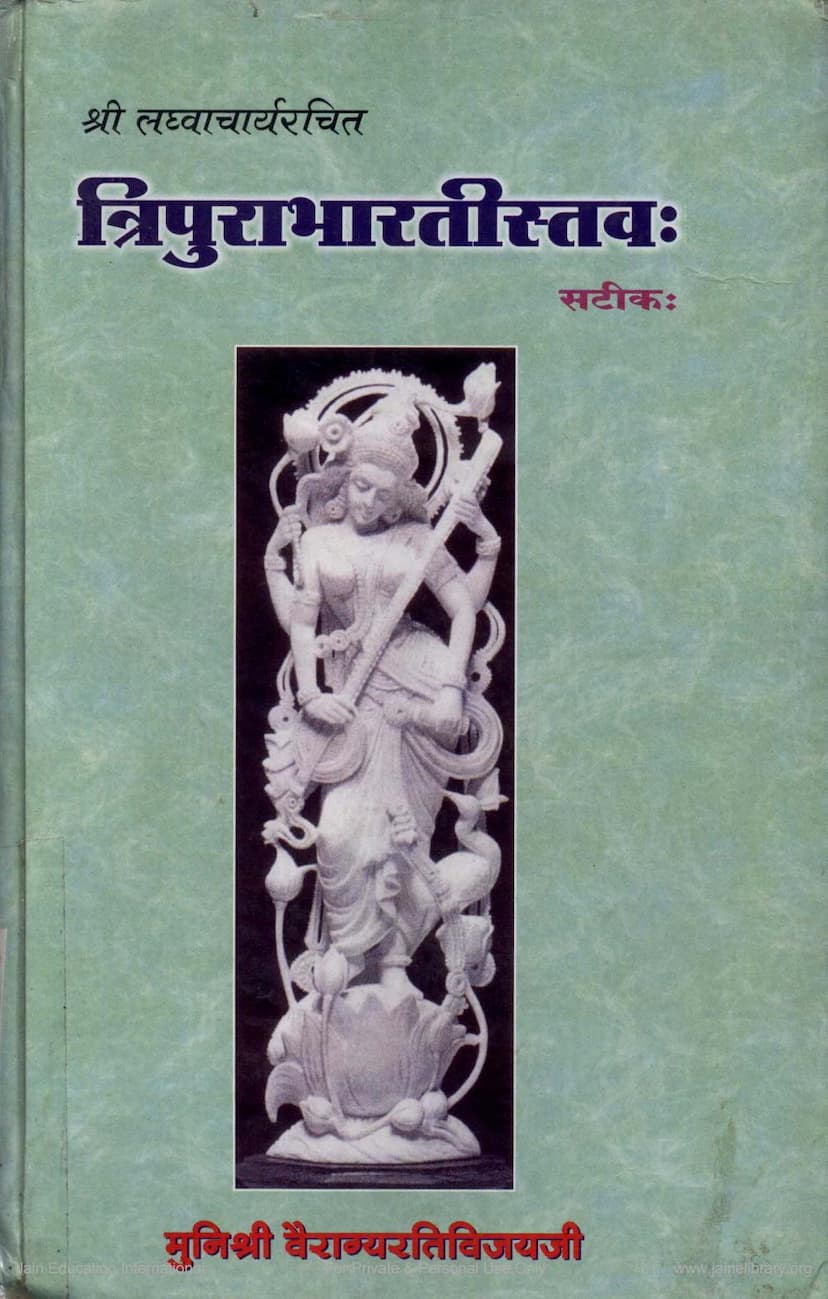Tripurabharatistav
Added to library: September 2, 2025

Summary
Here's a comprehensive summary of the Jain text "Tripurabharatistav" based on the provided pages:
Title: Tripurabharatistav (त्रिपुराभारतीस्तवः) Author: Laghvaacharya (लघ्वाचार्य) (also referred to as Laghukavi or Laghu Pandita) Publisher: Pravachan Prakashan, Pune Catalog Link: https://jainqq.org/explore/001966/1
Overview:
"Tripurabharatistav" is an ancient Jain tantric stotra (hymn) dedicated to the goddess Tripura, who is identified with the goddess Saraswati. The text is presented with two principal commentaries:
- Gyan Deepika (ज्ञानदीपिका): Authored by Acharya Somtilak Suri (आचार्य श्री सोमतलिकसू).
- Panjika (पञ्जिका): An anonymous commentary.
The publication also includes a Hindi translation of Pandit Lakshmandatt Shastri's commentary on Gyan Deepika. The current edition is based on previous printed versions and a manuscript obtained from the Acharya Kailassagar Suri Gyanmandir, Koba.
Key Themes and Content:
The stotra and its commentaries delve into various aspects, primarily centered around tantric practices and the worship of Tripura/Saraswati.
-
Tantric Background: The "Vimarsh" (विमर्श) section by Muni Dhurandhar Vijay provides an extensive explanation of the tantric tradition, its philosophical underpinnings (Shaiva and Shakta darshanas), and its practical applications. It distinguishes between "Tantra Darshan" (philosophical tantra) and "Tantra Prayog" (practical tantra involving mantras, yantras, and rituals).
- Shaiva Darshan: The text briefly outlines the core tenets of Shaiva philosophy, including its concepts of Pati (Lord Shiva), Pashu (soul), and Pash (bondage), and the liberation process.
- Tantra Prayog: It explains that Tantra Prayog aims to fulfill worldly desires by invoking supernatural powers (deities). It differentiates between South Path (Dakshin Margi) and Left Path (Vam Margi) practices, the latter involving the "Panchamakara" (five Ms: Madya, Mansa, Matsya, Mudra, Maithuna).
- Jain Perspective on Tantra: The text emphasizes that Jainism, with its core principles of Karma and Ahimsa, views practical tantra (especially that involving violence) with caution, labeling it as "papashrut" (sinful scripture). However, it acknowledges a "Jain Tantra" that focuses on purity of intent and means, utilizing mantras and the worship of benevolent deities like Yakshinis and Vidyadevis for spiritual upliftment and the propagation of Jain teachings.
-
The Stotra's Nature:
- Tantric Hymn: "Tripurabharatistav" is identified as an ancient tantric stotra. Its verses are imbued with mantra seed syllables (bijaksharas) and describe various forms of meditation and rituals.
- Origin and Attribution: The stotra's authorship is attributed to Laghvaacharya, possibly a poet from the Charana lineage associated with the Tripura Bharati shrine at Ajari in Rajasthan. The "Utthanika" (उत्थानिका) section describes an incident where an unlettered eight-year-old boy, under the influence of a pandit, composed this stotra praising Tripura Devi (Saraswati).
- Identification with Saraswati: The stotra is explicitly linked to Saraswati through the name "Bharati" and descriptions that align with the iconography of Saraswati, such as holding a book and rosary, and her association with speech and knowledge. The name "Tripura" itself is explained as referring to Saraswati's dominion over the three bijaksharas: ऐं (Aim), क्लीं (Klim), and सौं (Saum).
-
Commentaries' Approach:
- Gyan Deepika: This commentary by Acharya Somtilak Suri elaborates on the meaning of the verses, the mantra seed syllables (bijaksharas), their pronunciation, meditative practices associated with them, and various forms of Tripura Devi. It highlights the secretive nature of tantric practices, often passed down through guru-shishya parampara.
- Panjika: This commentary offers a more concise explanation, focusing on the literal meaning of the words and the derivation of mantras and their significance.
-
Mantras and Meditations: The stotra is rich with tantric elements:
- Bijaksharas: The first few verses detail the significance and meditative visualization of the core bijaksharas associated with Tripura/Saraswati: ऐं (Aim), क्लीं (Klim), and सौं (Saum). These are linked to knowledge, desire, and action respectively, and their precise pronunciation and visualization are crucial.
- Forms of Meditation: Various forms of meditating on Tripura Devi are described, associated with different colors (red for attraction, golden for wealth, fierce appearance for mental clarity), specific body parts (lallat, head, heart), and desired outcomes (knowledge, eloquence, wealth, power, liberation).
- Deity's Names and Powers: The stotra mentions numerous names of Tripura Devi (e.g., Lakshmi, Jaya, Kshemankari, Shabari, Mahabhairavi, Tara) and associates them with specific benefits and protections in various situations (royal courts, battles, dangerous journeys, fear of spirits, confusion, drowning). It also lists 64 Yoginis and their associated mantras and yantras.
- Mantra Siddhi: The text outlines the fruits of chanting specific mantras derived from the stotra, ranging from worldly gains like wealth, kingdom, and influence over others to spiritual liberation. The importance of mantra repetition (japa) and homa (fire rituals) is emphasized.
-
Structure and Compilation:
- The stotra consists of 21 verses.
- The editing process involved comparing previous editions and a manuscript.
- The work is dedicated to the memory of Acharya Shrimad Vijay Mahodayasurishwarji Maharaj.
Significance:
The "Tripurabharatistav" is presented as a powerful tantric hymn that, when properly understood and practiced under the guidance of a guru, can lead to both worldly accomplishments and spiritual attainments. The commentaries provide valuable insights into the historical and philosophical context of tantric practices within Jainism and broader Indian traditions. The inclusion of the "Vimarsh" is particularly significant for understanding the theoretical and practical aspects of Tantra in relation to Jain dharma.